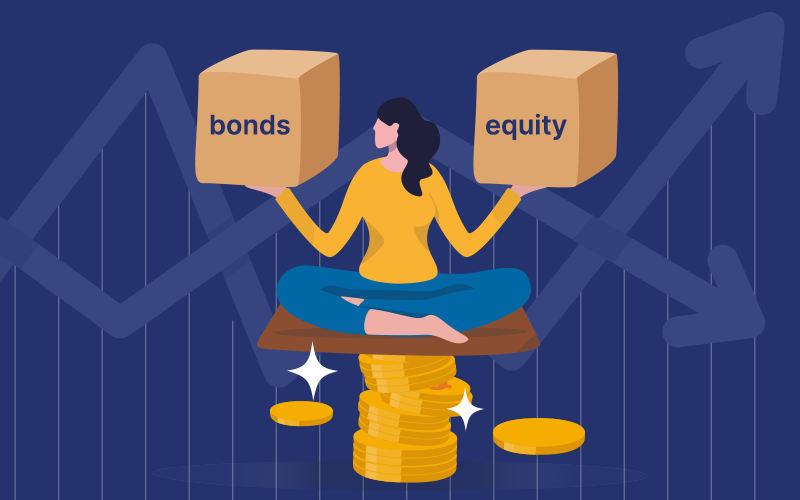The term ‘balanced funds’ is suggestive of its balanced asset allocation to both equities/stocks and debt/bonds. It means that the funds are allocated to different asset classes in a balanced proportion that generates stable returns. They are similar to other hybrid funds, that is, a mixture of growth and income money market instruments. Balanced funds limit the downside of equity-oriented investments as debt securities in the portfolio act as a cushion against market fluctuations. At the same time, they give higher returns than pure debt funds as the equity segments earn handsome returns in the bull market.
Understanding Balanced Funds
As defined by the name itself, balanced funds consist of equities and debt securities in an equitable ratio. The balanced approach helps to diversify the portfolio by giving the right risk-reward balance. It leads to capital appreciation while building a safety net against potential risks. Alternatively, it earns higher returns than plain vanilla debt investments. Therefore, investors seeking modest capital appreciation along with the security of returns can go for Balanced Funds. It is advisable for investors with low-risk appetites who want a strategic mix of income, medium capital generation, and protection against market swings to invest in these funds.
Balanced Funds Vs Hybrid Funds
A common point of confusion among investors is whether balanced funds are the same as hybrid funds, different, or are balanced funds a subcategory of hybrid funds. So here is the comparison:
- Balanced funds are indeed a subcategory and a type of hybrid fund among many others
- Hybrid funds tend to allocate the fund corpus to both equities and debt in a fair ratio; however, they can be equity-oriented or debt-focussed. Likewise, they are classified as aggressive or equity hybrid funds and conservative or debt-oriented hybrid funds. Aggressive hybrid funds must have a fund allocation of at least 65% to equities
- Balanced funds, on the other hand, have a more equitable approach to asset allocation. They follow the 60%-40% ratio of allocating the fund corpus to equity and debt instruments. They can either invest 60% in equities and 40% in debt or vice-versa. This is the SEBI (Securities and Exchange Board of India) mandate where the asset allocation has to be fixed and arbitrage position is not allowed either.
Are Balanced Funds and Balanced Advantage Funds Same?
Investors often ask if balanced funds and balanced advantage funds are the same and the answer to this question is NO. Investors must keep the following factors in mind to understand the difference between the two:
- Balanced Advantage Funds are more popularly known as Dynamic Asset Allocation Funds where fund managers can dynamically switch the asset allocation to different asset classes. Balanced Funds have to follow the fixed ratio of the asset allocation of 60%-40% and hence, have narrowband flexibility
- Fund managers of balanced advantage funds assess the market sentiments and accordingly invest in equities and debt. If they expect the market headwinds, they turn towards higher debt allocation, and if markets favor, they increase the equity investments. They have more freedom to shift the corpus
- On the other hand, balanced funds can be switched from 60% equity allocation to 40% and from 40% debt allocation to 60%
- Amidst all differences, there is one similarity between the two, it is that both are a type of hybrid funds
Features of Hybrid Funds
Balanced Funds have come into existence after the re-categorization of mutual funds by SEBI that mandated the 60%-40% asset allocation to debt and equity. Below are some notable features of hybrid funds:
- They are almost equally exposed to both segments of equities and debt. Therefore, investors get a healthy mix of the two asset classes
- They invest in all types of stocks and debt securities, from low to medium to high risk
- The asset allocation of balanced funds is fixed to be in a specific ratio and can be modified by a narrow margin. It cannot be changed as per the market requirements like balanced advantage funds. Also, a mutual fund house or an AMC (Asset Management Company) can either offer aggressive hybrid funds or balanced hybrid funds and not both
- Balanced funds offer diversity by default and the benefit of two funds in one, that is both income and capital building. They aim at building wealth with a stable portfolio and hence, strike a risk-reward balance
Who should Invest?
It has always been said that investments are a matter of personal choice as different investors have different needs and varying investment capacities. All investors should consider these three things:
- The scheme’s objective should match their goal
- The investment time horizon should be suitable
- The risk profiles of the investor and the fund should be in sync
So, investors who wish to invest in balanced funds must align themselves with the following factors:
- This type of fund gives optimum returns in the long term. So, investors with intermediate to long-term horizons (5-10 years) should invest in them. Investors with long-term goals such as retirement funds, or medium-term goals such as modest capital accumulation with a revenue source can consider balanced funds
- Beginners who are new to mutual fund investment and are skeptical about high-risk-reward funds like equity funds can invest in balanced funds. They have long-term growth potential with the moderation of portfolio volatility
- Investors with low risk tolerance who want to invest in funds that are capable of offering better returns than debt funds yet less risky than equity funds can invest
- Investors with no source of revenue can also invest in these funds to generate a steady stream of income along with wealth creation in the long run that can outpace inflation. The dividend payouts from equities and the periodic payments from corporate bonds and money market instruments can serve as regular income for investors
- Equities give ownership in the company where you become entitled to have a share in their profit revenue. These are the growth instruments that help in wealth creation. However, you also become a participant bearing all the inherent risk and a shareholder of the loss if bankruptcy occurs. On the other hand, with debt and bonds, investors have a claim against the company, and the latter is bound to return the invested money back to the bondholders, even with less interest on it. This helps in cushioning the volatility impact of the stocks
Wrapping it up:
Balanced funds, self-explanatory by their name, are funds that have a strategic mix of equities and debt through a balanced asset allocation. It contains the asset mix in a specific ratio of 60-40% where the healthy dose of equities and debt serves two purposes. While investors gain capital earnings from equity investments of the fund, the debt portion fortifies the portfolio against market downturns. Equity acts as a hedge against inflation in the long run and debt hedges against volatility. Despite being conservative in nature, they offer better returns than debt instruments and hence they are a perfect combination of an income, capital, and stable portfolio.










